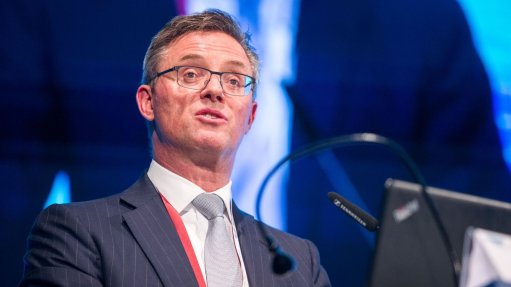Nene promises ‘strict adherence’ to expenditure ceiling as tax collections come under strain
Finance Minister Nhlanhla Nene promised “strict adherence” to government’s expenditure ceiling when outlining his Medium-Term Budget Policy Statement (MTBPS) on Wednesday, which took place amid protests inside and outside of Parliament over university fee increases.
However, the statement still confirmed some fiscal slippage, as revenue and growth projections were realigned to South Africa’s domestic economic constraints, as well as to new global uncertainties.
The 2015 Budget deficit was forecast to come in at 3.8% of gross domestic product (GDP), but widen by about 0.7% of GDP in 2016/17 and 2017/18, to 3.3% (2.6%) and 3.2% (2.5%) respectively, when compared with previous forecasts. The deficit would remain at 3% of GDP in 2018/19.
“Revenue growth will continue to outpace spending growth, narrowing the budget deficit from 3.8% in the current year to 3% in the outer year of the medium-term expenditure framework. Over this period, government will restore the primary balance – the gap between revenue and non-interest spending – ensuring a sustainable fiscal path.”
But South Africa’s performance in managing its Budget deficit and debt would be heavily scrutinised by credit rating agencies, which remained concerned that government debt could become unsustainable and breach the 50% debt-to-GDP level.
Nene said government’s “central fiscal objective” over the medium term would be to stabilise the growth of debt as a share of GDP and argued that, despite the deficit slippage outlined in the MTBPS, government was “staying the course” regarding fiscal consolidation.
He was, thus, optimistic that South Africa would avoid another ratings downgrade, with his director-general Lungisa Fuzile highlighting that the deviation from the earlier deficit forecasts had not been the result of additional expenditure.
Fuzile added that even its R23-billion support for State-owned utility Eskom had been financed within the “deficit neutral” framework outlined in February. The money had been raised through the disposal of government’s stake in Vodacom and Nene said future noncore disposals would be considered should a specific financing need arise at other State-owned companies.
However, Investec economist Annabel Bishop described the fiscal metrics in the MTBPS as "poorer than expected" and said South Africa would receive a one notch credit rating downgrade from Fitch – from BBB to BBB- for foreign long-term debt, and from BBB+ to BBB for local currency long-term debt – in its next country review in December.
"This will likely bring the Fitch rating closer to alignment with the Standard & Poor's (S&P) rating for South Africa. S&P is ultimately expected to downgrade its BBB+ rating on South Africa's local currency long-term debt to BBB, with a negative warning outlook first implemented, mainly on the subdued nature of GDP growth, aided by higher interest rates. Moody’s could yield a negative outlook at worst for South Africa on the basis of the rise in the gross loan debt as a percentage of GDP projection," Bishop said in a research note.
Nomura's Peter Attard Montalto argued in his note that there was probably enough in the MTBPS to avoid an immediate downgrade by Moody’s. "However, with such a strong set of downside risks to next year’s growth, a downgrade still looks likely."
DEBT STABILISATION?
The National Treasury added that continued revenue growth and strict adherence to the planned expenditure ceiling were projected to result in gross debt stabilising at 49.4% of GDP in 2018/19.
Government debt had surge since the global financial crisis, from 26% of GDP in 2008 to 47% in March and a further R600-billion in debt would be accumulated in the coming three years.
Debt-service costs remained the fastest-growing spending category, with average yearly growth of 10.9% over the MTBPS period.
In 2015, debt-service expenditure would grow to R127.9-billion, a significant sum in light of a social-protection budget of R154-billion and a health budget for the year of R157.7-billion. It also far outstripped the figure set aside for post-school education of R63.7-billion.
But holding the debt line would become even more difficult in light of a R35-billion downward revision to government’s gross tax revenue projections for the three-year period between 2015/16 and 2017/18 – a fall attributed to a weaker economic growth outlook.
GROWTH OUTLOOK CUT
As anticipated, the growth forecast for 2015 was reduced to 1.5%, from the 2% outlined in the February Budget.
The projection for 2016 was also reduced to 1.7% from 2.4%, while the weak outlook was extended to the two outer years of the MTBPS, with the National Treasury forecasting expansion of 2.6% (3%) and 2.8% in 2017 and 2018 respectively.
Constrained electricity supply remained the single largest drag on economic activity, with the National Treasury estimating that supply disruptions would cost close to one percentage point of annual GDP growth.
Gross tax revenue for 2015/16 was lowered by R7.6-billion, owing to weak corporate income tax collections in the year to date, as company earnings were undermined by the steep decline in commodity prices and the slowdown in economic activity.
TAX-HIKE CAUTION
However, Nene said that proposals for additional taxes would be “approached with caution”. In February, Nene announced hikes in personal income tax rates and indicated that the Davis Tax Committee (DTC), led by Judge Dennis Davis, was still considering other possible changes, which were “essential to fund government’s ambitious policy agenda”.
Recommendations already under consideration related to profit shifting and the misuse of transfer pricing, changes to mining and small-business taxation, adjustments to value added tax and estate duties. A draft carbon-tax Bill would also be released soon, but Nene stressed that implementation, which had been mooted for 2016, would only follow “exhaustive” consultations with stakeholders.
Nene indicated that he would also be seeking further advice on wealth taxes. “The committee has published an instructive report on the role of the tax system in supporting inclusive growth, employment, equity and fiscal sustainability.”
The Minister stressed that all tax changes would be consulted, but that government would “act decisively” should conditions change on either the growth or revenue front.
CEILING THE LIMIT
The immediate focus, however, would be strict adherence to the expenditure ceiling first unveiled in the 2014 MTBPS.
“The expenditure ceiling remains the primary tool to stabilise debt. No resources will be added to the spending ceiling over the next two years.”
Spending over the three-year period was forecast at R4.7-trillion.
The MTBPS proposed a new long-term fiscal guideline to align the spending ceiling with the long-term path of economic growth. “Beginning with the 2016 Budget, government will align spending limits in the outer year of the medium-term expenditure framework with the long-term path of GDP growth, building on government’s countercyclical and sustainable approach to fiscal management.”
Comments
Press Office
Announcements
What's On
Subscribe to improve your user experience...
Option 1 (equivalent of R125 a month):
Receive a weekly copy of Creamer Media's Engineering News & Mining Weekly magazine
(print copy for those in South Africa and e-magazine for those outside of South Africa)
Receive daily email newsletters
Access to full search results
Access archive of magazine back copies
Access to Projects in Progress
Access to ONE Research Report of your choice in PDF format
Option 2 (equivalent of R375 a month):
All benefits from Option 1
PLUS
Access to Creamer Media's Research Channel Africa for ALL Research Reports, in PDF format, on various industrial and mining sectors
including Electricity; Water; Energy Transition; Hydrogen; Roads, Rail and Ports; Coal; Gold; Platinum; Battery Metals; etc.
Already a subscriber?
Forgotten your password?
Receive weekly copy of Creamer Media's Engineering News & Mining Weekly magazine (print copy for those in South Africa and e-magazine for those outside of South Africa)
➕
Recieve daily email newsletters
➕
Access to full search results
➕
Access archive of magazine back copies
➕
Access to Projects in Progress
➕
Access to ONE Research Report of your choice in PDF format
RESEARCH CHANNEL AFRICA
R4500 (equivalent of R375 a month)
SUBSCRIBEAll benefits from Option 1
➕
Access to Creamer Media's Research Channel Africa for ALL Research Reports on various industrial and mining sectors, in PDF format, including on:
Electricity
➕
Water
➕
Energy Transition
➕
Hydrogen
➕
Roads, Rail and Ports
➕
Coal
➕
Gold
➕
Platinum
➕
Battery Metals
➕
etc.
Receive all benefits from Option 1 or Option 2 delivered to numerous people at your company
➕
Multiple User names and Passwords for simultaneous log-ins
➕
Intranet integration access to all in your organisation





















